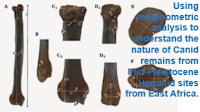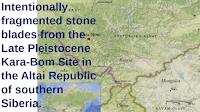The first major evolutionary radiation of the Vascular Plants occurred in the Devonian, and was a vital step on the path towards the formation of almost all modern terrestrial ecosystems. During this time, three distinct groups of Vascular Plants began to produce Trees, the Pseudosporochnaleans, Fern-like Plants which may have been related to the true Ferns, Archaeopteridaleans, Fern-like Plants thought to have been ancestral to the Gynosperms, and Lycopsids, or 'Giant Club Mosses'. The Lycopsids are thought to have been the first of these groups to appear, and played an important role in early terrestrial ecosystems, forming the first forests in the Devonian, and dominating the forests of the Carboniferous, providing the majority of the biomass for the great Carboniferous coal deposits. Unlike the Carboniferous forests, the forests of the Devonian are relatively poorly known, with most examples coming from Europe and North America, and only a single example on Svalbard Island having produced in situ Lycopsid trees before 2019.
South China is known to have been a significant centre for the evolution of Lycopsids, and may have been the place where the first forests appeared. In 2019 a Devonian Lycopsid forest was reported at Xinhang in Anhui Province, where trees of the Lycopsid Guangdedendron micrum were uncovered at a working clay pit, yielding the oldest known examples of stigmarian roots.
Because this site is being actively worked for commercial reasons, further fossils are being continuously uncovered, adding to our knowledge of this early forest-forming Lycopsid Tree. In a paper published in the journal BMC Ecology and Evolution on 23 May 2022, Xue Gao of the Key Laboratory of Orogenic Belts and Crustal Evolution at Peking University, Le Liu of the School of Geoscience and Surveying Engineering at the China University of Mining and Technology-Beijing, Min Qin of the Institute of Geology and Paleontology at Linyi University, Yi Zhou, also of the Key Laboratory of Orogenic Belts and Crustal Evolution at Peking University, Lei Mao of the Anhui Geological Museum, and De‑Ming Wang, once again of the Key Laboratory of Orogenic Belts and Crustal Evolution at Peking University, present an updated description of Guangdedendron micrum, based upon new material that has become available over the last three years.
Guangdedendron micrum was a small Lycopsid Tree, with separate male and female plants, in which adult Plants produced seeds only once before dying. It produced stigmaria-type rhizomous roots, which divided bilaterally on four different axes, and produced helical rootlets. The step branched dichotomously at its terminus, producing a single large strobilus ('cone'). Leaves were narrow with entire margins, and arranged spirally on the stems. The Stobili were typically singular, but in some cases branched dichotomously once. They were roughly cylindrical in shape, with helically arranged megasporophylls (spore bearing leaves), each of which had a keeled pedicel (leaf stem) and an upturned lamina (leaf); spores were born on the upper surface of these laminae.
The rhizomatous roots reached down to about 27 cm beneath the soil surface, with each axes being 8.3-31 cm long, and arranged at angles of 19-60° to the ground surface. The rootlets are up to 27.2 cm long and 7 cm wide. The largest preserved stems are 88 cm high and about 18.7 cm in diameter. The vegetative leaves 2.0-9.2 cm long and 0.12-0.90 cm wide, each having a single vein. The largest stobili reach about 23.4 cm long and 3.0 cm wide. The sporangia laminae reach about 18 mm long and 5.8 mm wide. The megasporangia (spore producing bodies on the leaves are 4.0-7.4 mm long.
The new material presented by Gao et al. shows that the stigmarian rhizomorph root of Guangdedendron micrum has four evenly distributed axes, which grew to about 31 cm in length, before dichotomously branching once. These rhizomorph roots angle downwards between 19-51° to the ground surface, covering an area up to 41.1 cm wide and 27.0 cm deep. The first order branches (which arise from the initial dichotomous branching) grow to about 7.2-7.8 cm in length, before dividing again to produce third order branches, which reach 2.8-6.5 cm in length. Rootlets are arranged helically along the roots and reach up to 12 mm in length and 5 mm in width. These are generally unbranched, and do not produce root hairs.

In‑situ rooting systems of Guangdedendron micrum from Yongchuan mine. (A) Stem and connected rhizomorph axes. (B) Rooting system with branched rhizomorph axes. PKUB21015. (C) Stems with connected rhizomorph axes bearing rootlets. (D) Top view of the specimen shown in (A), after removing the stem and surrounding rocks partially peeling off. A rooting system with four once‑dichotomized rhizomorph axes. Arrows indicating 8 second‑order branches. (E) Stem base and connected two rhizomorphic axes. (F), (G) Rhizomorphic axes connected to moulds of stem bases and bearing rootlets. Scale bars: (B), (D), (G) 5 cm; diameter of the coin for scale: 2 cm (A), (C), (E), (F). Gao et al. (2022).
Stems have been found preserved as compressions and erect casts. These reach up to 71.3 cm high and 1.1-12.2 cm in diameter, excluding the expanded bases which form the connection to the root system. Dichotomous branching is rare, but does occur, happening no more than twice on a single plant, with the branches angled at 13-43°.

Stems and vegetative leaves of Guangdedendron micrum, from Yongchuan (A), (B), (D), (G)–(M), (O)–(Q), (S), (U), (V) and Jianchuan (C), (E), (F), (N), (R), (W) mines. (A), (B) In‑situ stems with expanded bases. PKUB21000, 21014. (C) Two adjacent in‑situ stems with expanded bases. (D) An in‑situ stem with an expanded base. (E), (F) Two sides of a stem displaying basal expansion and helically arranged oval fissures of broken leaf cushions after leaf abscission. PKUB21004. (G)–(J) Stems perpendicular to the bedding plane. (H) YC‑103. (K) An in‑situ stem with leaf cushions. (L) A once‑dichotomised stem. YC‑101. (M), (N) Twice‑dichotomised stems. (M) YC‑102. (O) A once‑dichotomised leafy stem with leaf bases. (P), (Q) Part and counterpart of helically arranged leaf cushions. YC‑105, 104. (R) A stem with helically arranged leaf cushions. (S) Fusiform leaf cushions. PKUB21013. (T) Line illustration of a leaf cushion based on arrowed portion in (Q). (U) Helically arranged leaf bases. Arrow indicating portion enlarged in (V). PKUB21007. (V) Enlargement of arrowed portion in (U), indicating fusiform leaf bases with middle vertical grooves in the lower part. (W) Helically arranged leaf bases, each showing a vertical groove in the middle. PKUB16052a. Scale bars: (A), (E), (F) 2 cm, (D), (G) 5 cm, (P)–(R), (U), (W) 1 cm, (S), (T), (V) 5 mm; diameter of the coin for scale: 2 cm (B), (C), (H), (J), (K), (M)–(O); length of the hammer for scale: (I) 28.6 cm, (L) 27.3 cm. Gao et al. (2022).
Vegetative leaves are 3.5-8.5 cm long and 0.29 to 0.90 cm wide, and spindle-shaped with entire margins and a single vein running the entire length of the leaf. These are arranged spirally around the stems, departing at an angle of 59-98° to the stem. Slender twigs, interpreted as the stems of juvenile plants, have leaves to their tips arranged in a similar way.
Vegetative leaves of Guangdedendron micrum from Jianchuan mine. (A), (B) Terminal parts of vegetative axes bearing leaves. PKUB21001, 16067. (C), (D) Part and counterpart of a terminal vegetative axis. PKUB21017a, 21017b. (E), (F) Tapering vegetative axes with persistent linear leaves. Arrow indicating portion in (F) enlarged in (G). PKUB21018, 16144. (G) Enlargement of arrowed portion in (F), showing veins of vegetative leaves. Scale bars: (A)–(E) 2 cm, (F) 10 cm, (G) 1 cm. Gao et al. (2022).
The fertile stems are up to 6.4 cm long and 0.21-0.55 cm wide, and tipped by strobili. One fertile stem found was 17.6 cm wide, and branched dichotomously, producing two daughter stems angled at 60° to one-another. Vegetative leaves on the lower part of the fertile stems are angled at 70-85° to the stems, and are curved at their tips.

Fertile axes and strobili of Guangdedendron micrum from Jianchuan (A)–(E), (H)–(J), (L), (M) and Yongchuan (F), (G), (K) mines. (A), (B) Part and counterpart of a once‑dichotomized axis bearing linear leaves and a single strobilus. (C) A strobilus without basal fertile axis preserved. (D), (E) Part and counterpart of a strobilus terminating a fertile axis. PKUB16001a, 16001b. (F), (G) Part and counterpart of terminal strobili in pairs, with sporophylls along central strobilar axis and persistent vegetative leaves on fertile axis. PKUB21002a, 21002b. (H) At least eight strobili (arrows 1–8) preserved in the same direction (1 and 2, 7 and 8 possible paired, respectively). PKUB16047. (I) A dichotomized strobilus. PKUB21011. (J) Terminal strobili in pairs. PKUB16035. (K) A single and a pair of strobili perpendicular to the layers. (L) A short strobilus may partially preserved. PKUB16065. (M) Strobilus displaying central strobilar axis. PKUB16020a. Scale bars: (A), (B) 5 cm, (C), (J), (L), (M) 1 cm, (D)–(I) 2 cm; diameter of the coin for scale: 2 cm (K). Gao et al. (2022).
The strobili at the end of the fertile stems are pendulous and usually singular, although they are sometimes found in pairs and occasionally branch dichotomously. They are cylindrical and slightly curved, reaching a maximum of about 23.4 cm in length. Sporophylls are tightly packed and helically arranged around these strobili. Each sporophyll comprises a pedicel projecting horizontally from the main stem, and a lamina angled at about 110° to this pedicel. These laminae are an elongated triangle shape, reaching 12-18 mm in length.

Stems and strobili of Guangdedendron micrum from Jianchuan (A)–(G), (I), (L)–(O) and Yongchuan (H), (K), (P), (Q) mines. (A), (B) Two sides of a stem with expanded base and leaf cushions. PKUB21005. (C), (D) Two sides of a stem. PKUB21006. (E), (F) In-situ once-dichotomized stems. Two arrows in (E) indicating two daughter axes. (G) Oval fissures helically arranged along stem. (H) Oval fissures helically arranged along in-situ stem. (I) Enlargement of portion of stem (arrow), showing a ligule pit (Lp) and a vascular bundle scar (Vs). (J) Interpretative line drawing of helically arranged leaf bases, indicating outlines (black lines) and parastichies (red dotted lines) of leaf bases. PKUB16049. (K), (L) Dichotomised fertile axes with terminal single strobilus. (M), (N) Terminal strobili in pairs. PKUB16097, 16099. (O) Dichotomised fertile axis with partially preserved strobili. (P) Over ten strobili preserved in the same direction. (Q) A possibly once-dichotomized strobilus. Scale bars: (A)–(D) 5 cm, (F), (L) 2 cm, (G), (M)–(O), (Q) 1 cm, (I) 2 mm, (J) 5 mm; diameter of the coin for scale: 2 cm (E), (H), (K), (P). Gao et al. (2022).
All of the strobili found produce megaspores (i.e. female spores), leaving the possibility that the male plants were quite different. Each sporaphyll has an ellipsoidal megasporangium 4.0-7.4 mm in length on its upper surface. Few of these can be seen clearly, as the upper surfaces are generally covered by the adjacent sporaphylls, but each megasporangium appears to contain multiple megaspores.

Sporophylls and spores of Guangdedendron micrum from Jianchuan mine. (A) A partially preserved strobilus, showing sporangia on the adaxial surface of sporophyll pedicels. PKUB16049. (B) A partially preserved strobilus, showing megaspores and sporophylls. PKUB16141. (C) Mid‑upper part of a strobilus with helically arranged sporophylls in face and lateral view. Arrow indicating portion enlarged in (H). PKUB16058. (D) Enlargement showing sporophyll laminae and pedicel in lateral view. (E) Enlargement showing sporophyll laminae and pedicel in lateral view and partially preserved sporangia, arrows indicating megaspores. (F) Enlargement of arrowed portion in (A), showing sporangia. (G) Enlargement showing sporophyll laminae in face view. (H) Enlargement of portion in (C) (arrow), showing sporophyll laminae in face view with downturned heels. (I) Part of a strobilus showing megaspores, the arrow indicating portion enlarged in (K). PKUB16020a. (J), (K) Enlargement showing megaspores and spiny ornamentations. (L) Megaspores with spiny ornamentations. Scale bars: (A), (C), (D) 1 cm, (B), (F) 5 mm, (E), (G)–(I) 2 mm, (J) 1 mm, (K), (L) 500 μm. Gao et al. (2022).
The absence of strobili producing microspores in the discovered specimens of Guangdedendron micrum is curious, particularly as a large number of specimens have now been found. Other Lycopsid species from the Devonian and Carboniferous are known have produced microsporangia and megasporangia on separate, but otherwise similar plants. It is possible that male Guangdedendron micrum plants were much less common than the female plants, or that the plants were able to reproduce parthenogenicly from unfertilised megaspores.
Reconstruction of the longest strobilus terminating the fertile axis after bifurcation. Scale bar is 2 cm. Gao et al. (2022).
Bifurcation (spliting in two) of the fertile stems and strobili of Lycopsids is rare, but has previously been recorded in other Late Devonian species. This appears to be caused by branching of a meristem (growth centre of a Plant) at the tip of the stem after the stem has switched to its fertile growth mode. In Guangdedendron micrum this can occur before the strobili, resulting in paired strobili, or on the strobilus itself, resulting in a forked strobilus. A similar branching can be seen in the fertile zones of some living Club Mosses and Ferns, although these are all epiphytic in habit, and it has generally been assumed that this is an adaptation to that lifestyle; something highly unlikely in Guangdedendron micrum, which has a well developed subterranean root system, and is in any case the largest Plant in its ecosystem.
See also...
Online courses in Palaeontology.
Follow Sciency Thoughts on Facebook.
Follow Sciency Thoughts on Twitter.





























































